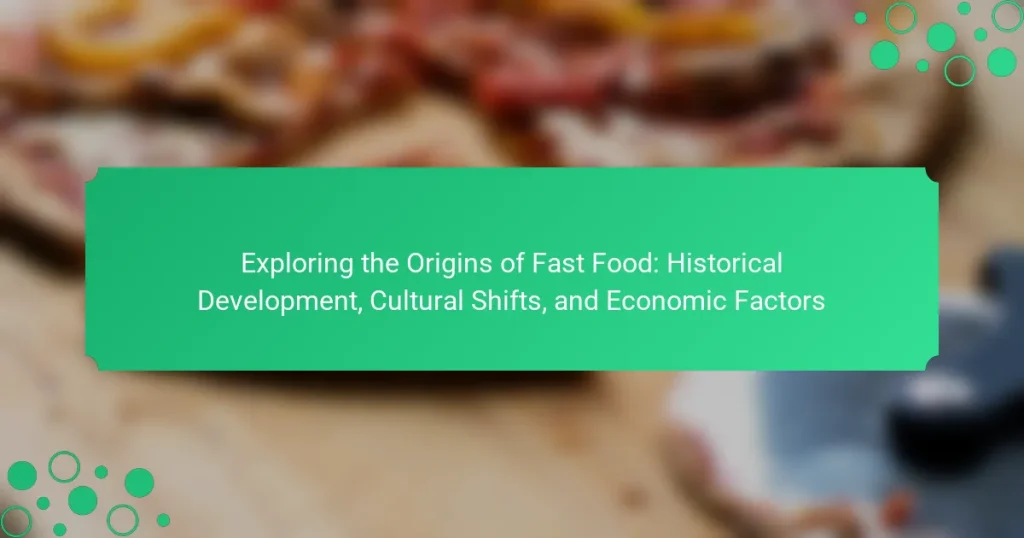Fast food, a dining concept that originated in the United States in the early 20th century, has evolved into a global phenomenon characterized by convenience and quick meal options. The establishment of key entities such as White Castle and McDonald’s marked significant milestones in the industry’s development, driven by innovations in food preparation and the rise of car culture. Economic factors such as urbanization, busy lifestyles, and increased disposable incomes have fueled the demand for fast food, while globalization has facilitated its expansion into diverse markets. Current trends indicate a shift towards healthier, plant-based menu options and sustainability efforts, alongside advancements in technology and delivery services that cater to consumer preferences.

What are the origins of fast food?
Fast food originated in the United States in the early 20th century. The concept was popularized by the establishment of drive-in restaurants and fast food chains. White Castle, founded in 1921, is often credited as the first fast food chain. The introduction of assembly line techniques in food preparation increased efficiency. McDonald’s, which began as a barbecue restaurant in 1940, revolutionized the industry with its franchise model. The rise of car culture in post-World War II America fueled the demand for quick meals. Fast food has since become a global phenomenon, adapting to various cultures and preferences.
How did fast food evolve over time?
Fast food evolved from early 20th-century dining concepts to a global industry. In the 1920s, drive-in restaurants began to emerge in the United States. These establishments offered quick service and convenience to customers. The 1940s saw the rise of fast food chains, with McDonald’s opening its first franchise in 1955. This marked a significant shift toward standardized menus and mass production. By the 1970s, fast food became a staple of American culture, driven by busy lifestyles and economic growth. The globalization of fast food began in the 1980s, with chains expanding internationally. Today, fast food encompasses a wide variety of cuisines and continues to adapt to consumer preferences.
What key historical events influenced the development of fast food?
The development of fast food was influenced by several key historical events. The introduction of the assembly line by Henry Ford in the early 20th century revolutionized food production. This innovation allowed for mass production and efficiency in food preparation. The rise of automobile culture in the 1950s increased demand for quick, convenient meals. The establishment of drive-in restaurants catered to this new lifestyle. Additionally, the post-World War II economic boom led to increased consumer spending on dining out. The expansion of franchises, starting with McDonald’s in the 1950s, standardized fast food across the United States. These events collectively shaped the fast food industry as we know it today.
How did technological advancements contribute to the rise of fast food?
Technological advancements significantly contributed to the rise of fast food. Innovations in food processing allowed for quicker meal preparation. Refrigeration technology enabled longer food preservation, reducing waste. The development of assembly line techniques streamlined food production. This increased efficiency in kitchens and reduced labor costs. The introduction of drive-thru service enhanced customer convenience. Advancements in transportation improved supply chain logistics for fresh ingredients. Marketing technology, including television advertising, expanded brand reach to consumers. These factors collectively transformed the fast food industry into a dominant market force.
What cultural shifts have impacted the fast food industry?
Cultural shifts have significantly impacted the fast food industry. Increasing health consciousness among consumers has led to a demand for healthier menu options. This shift is evidenced by the rise of salads, fruit, and plant-based alternatives in fast food chains. Additionally, the emphasis on convenience has driven the growth of delivery services and mobile ordering. Social media’s influence has also reshaped marketing strategies, with brands engaging consumers through platforms like Instagram and TikTok. The globalization of food culture has introduced diverse cuisines into fast food menus, appealing to a broader audience. Environmental concerns have prompted companies to adopt sustainable practices, such as reducing plastic use and sourcing ingredients locally. Lastly, changing demographics, particularly among younger generations, have shifted preferences towards ethical and transparent food sourcing. These cultural shifts collectively illustrate the evolving landscape of the fast food industry.
How have changing consumer preferences shaped fast food offerings?
Changing consumer preferences have significantly shaped fast food offerings. Health consciousness has led to an increase in healthier menu options. Many fast food chains now offer salads, fruit, and whole grain products. Additionally, the demand for transparency has prompted companies to disclose nutritional information. This shift is evident as brands like Chipotle and Panera Bread emphasize fresh ingredients. Moreover, the rise of plant-based diets has resulted in the introduction of meat alternatives. For instance, Burger King’s Impossible Whopper caters to vegan and vegetarian consumers. Convenience remains a priority, with many chains enhancing drive-thru and delivery services. Overall, fast food offerings continue to evolve in response to consumer trends and preferences.
What role does globalization play in the evolution of fast food culture?
Globalization significantly influences the evolution of fast food culture. It facilitates the spread of fast food brands across international borders. This expansion introduces diverse culinary practices to new markets. Globalization also promotes the standardization of food production and service methods. Consequently, fast food chains can maintain consistency in quality and taste worldwide. The rise of global communication networks enhances marketing strategies for these brands. Cultural exchange through globalization leads to the fusion of local cuisines with fast food offerings. For instance, McDonald’s adapts its menu to include local flavors in various countries. This adaptability helps fast food chains thrive in diverse cultural landscapes.

What economic factors have driven the growth of fast food?
The growth of fast food has been driven by several key economic factors. Increased urbanization has led to a higher demand for convenient meal options. Busy lifestyles have created a preference for quick and affordable food. The rise of disposable incomes has enabled consumers to spend more on dining out. Globalization has facilitated the expansion of fast food chains into new markets. Economies of scale have allowed companies to reduce costs and increase profitability. Additionally, aggressive marketing strategies have attracted a wide customer base. These factors combined have significantly contributed to the fast food industry’s expansion.
How do market demand and supply influence fast food pricing?
Market demand and supply significantly influence fast food pricing. When demand for fast food increases, prices tend to rise due to higher consumer interest. Conversely, if supply exceeds demand, prices may decrease to attract customers. Seasonal trends, such as summer or holidays, can also affect demand and pricing. For instance, during peak times, prices may increase as restaurants capitalize on higher foot traffic. Additionally, the cost of raw materials impacts supply, affecting overall pricing strategies. According to the Bureau of Labor Statistics, food prices have fluctuated based on supply chain disruptions and consumer demand changes. This dynamic interplay between demand and supply shapes the pricing landscape in the fast food industry.
What economic trends have led to the proliferation of fast food chains?
The proliferation of fast food chains is primarily driven by urbanization and increased consumer demand for convenience. Urbanization has led to busier lifestyles, making quick meal options more appealing. Additionally, the rise of disposable income allows more consumers to afford dining out. The expansion of highways and suburban areas has facilitated the growth of drive-thru services. Globalization has enabled fast food brands to enter new markets rapidly. Technological advancements have streamlined food production and distribution processes, reducing costs. Marketing strategies targeting younger demographics have further fueled the industry’s growth. According to IBISWorld, the fast food industry has consistently shown annual growth rates of around 3% in recent years, reflecting its resilience and adaptability in changing economic landscapes.
How do labor costs affect the fast food industry?
Labor costs significantly impact the fast food industry by influencing pricing, profitability, and operational efficiency. Higher labor costs can lead to increased menu prices, as businesses pass on expenses to consumers. This can reduce demand, particularly in price-sensitive markets. A 2020 study by the National Restaurant Association indicated that labor costs account for approximately 30% of total expenses in fast food establishments.
Moreover, rising wages can compel fast food chains to automate processes, which may reduce the number of employees needed. In 2021, McDonald’s announced plans to invest in technology to enhance efficiency amid increasing labor costs. Consequently, labor costs directly shape business strategies and consumer pricing in the fast food sector.
What are the implications of fast food on local economies?
Fast food impacts local economies by creating jobs and generating tax revenue. These establishments often employ a large number of workers, providing entry-level positions for many. According to the National Restaurant Association, the restaurant industry is one of the largest employers in the U.S., with over 15 million employees. Fast food chains contribute significantly to local tax bases through property and sales taxes. This revenue can fund public services and infrastructure improvements. However, fast food can also lead to negative economic implications. Local businesses may struggle to compete with large chains, potentially leading to closures. Additionally, fast food consumption can contribute to health issues, increasing healthcare costs for communities.
How does fast food impact employment rates in communities?
Fast food impacts employment rates in communities by creating job opportunities. Fast food restaurants often employ a large number of workers, especially in low-income areas. According to the National Restaurant Association, the restaurant industry employs over 15 million people in the U.S. Many of these jobs are entry-level positions. They provide essential work experience for young individuals. However, some studies suggest that fast food jobs may not offer long-term career growth. A report from the Economic Policy Institute indicates that fast food jobs typically pay lower wages. This can lead to economic instability in communities. Overall, while fast food can boost employment rates, it may also contribute to economic challenges.
What effects does fast food have on local food systems?
Fast food negatively impacts local food systems by undermining local agriculture and food diversity. It promotes reliance on industrial food production, which can displace small-scale farmers. This shift often leads to a reduction in the variety of foods available in local markets. Fast food chains typically source ingredients from large suppliers, limiting opportunities for local producers. Studies show that communities with more fast food outlets often experience decreased access to fresh, healthy food options. Additionally, fast food contributes to food deserts, where nutritious food becomes scarce. The economic power of fast food chains can overshadow local businesses, further destabilizing local food economies.

What future trends can we expect in the fast food industry?
Future trends in the fast food industry include increased plant-based menu options and sustainability efforts. Many consumers are shifting towards healthier diets. This trend is pushing fast food chains to incorporate more plant-based items. Additionally, sustainability is becoming a priority for consumers. Fast food companies are adopting eco-friendly packaging and sourcing ingredients responsibly. Technology is also influencing the industry. Automation and artificial intelligence are being integrated into operations. Delivery services are expanding rapidly, driven by consumer demand for convenience. These trends are supported by market research indicating a growing preference for healthier and sustainable dining options.
How is technology reshaping the fast food experience?
Technology is reshaping the fast food experience through automation and enhanced customer interaction. Drive-thru kiosks allow for quicker service and reduced wait times. Mobile apps enable customers to order ahead and customize meals. Digital menus display real-time updates on availability and promotions. Artificial intelligence improves inventory management and customer service. Contactless payment options increase convenience and safety. Data analytics provide insights into consumer preferences, guiding menu development. These advancements contribute to a more streamlined and efficient dining experience.
What innovations are emerging in fast food preparation and delivery?
Innovations in fast food preparation and delivery include automation, robotics, and advanced mobile ordering systems. Automation enhances efficiency in food preparation. Robotics are being used for cooking and assembling meals, reducing labor costs. Advanced mobile ordering allows customers to customize their orders seamlessly. Ghost kitchens are emerging, focusing solely on delivery without dine-in services. Contactless delivery methods are increasing for safety and convenience. AI-driven analytics optimize inventory management and customer preferences. These innovations are reshaping the fast food landscape to meet consumer demands.
How are sustainability practices influencing fast food operations?
Sustainability practices are significantly influencing fast food operations by driving changes in sourcing, packaging, and waste management. Many fast food chains are adopting locally sourced ingredients to reduce their carbon footprint. For example, companies like Chipotle emphasize using organic and non-GMO produce. Additionally, there is a shift towards biodegradable and recyclable packaging to minimize plastic waste. Brands like McDonald’s are committing to 100% recyclable packaging by 2025. Moreover, fast food operations are implementing waste reduction strategies, such as composting and food donation programs. Research indicates that 66% of consumers prefer brands that demonstrate environmental responsibility. These practices not only enhance brand image but also cater to the growing consumer demand for sustainability.
What practical tips can consumers consider when choosing fast food?
Consumers should consider nutritional value when choosing fast food. Look for options that are lower in calories, saturated fats, and sugars. Check the menu for healthier alternatives like salads or grilled items. Portion sizes are important; choose smaller sizes to control calorie intake. Reading nutritional information can help consumers make informed decisions. Comparing different restaurants can reveal healthier choices. Opt for water or unsweetened beverages instead of sugary drinks. Being mindful of additives and preservatives in fast food items is also beneficial. Finally, consider the frequency of consumption to maintain a balanced diet.
How can consumers make healthier choices in fast food restaurants?
Consumers can make healthier choices in fast food restaurants by selecting items with lower calories and higher nutritional value. They should opt for grilled options instead of fried items. Choosing salads or vegetable sides over fries is beneficial. Consumers can also request dressings or sauces on the side to control portions. Reading nutritional information available on menus helps in making informed decisions. Many fast food chains now provide calorie counts for items. Research indicates that awareness of calorie content can lead to healthier selections. A study published in the American Journal of Preventive Medicine found that calorie labeling influences consumer choices positively.
What should consumers know about fast food marketing strategies?
Consumers should know that fast food marketing strategies heavily target convenience and value. These strategies often emphasize speed and affordability. Promotions frequently use limited-time offers to create urgency. Fast food chains also utilize colorful packaging and mascots to appeal to children. Advertisements often highlight large portion sizes to attract consumers. Additionally, social media campaigns are increasingly used to engage younger audiences. Research shows that fast food advertising significantly influences children’s food choices. A study by the American Journal of Clinical Nutrition revealed that children are more likely to choose advertised foods over healthier options.
The main entity of this article is fast food, which has evolved significantly since its origins in the early 20th century United States. Key historical developments include the establishment of drive-in restaurants and the rise of fast food chains like White Castle and McDonald’s, which popularized standardized menus and mass production techniques. The article explores cultural shifts impacting consumer preferences, technological advancements in food preparation and delivery, and economic factors driving the industry’s growth, including urbanization and changing labor costs. Additionally, it addresses the implications of fast food on local economies and food systems, as well as future trends towards sustainability and healthier menu options.




